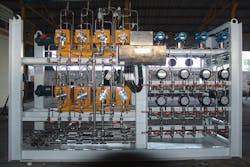Positive displacement (PD) flow meters are the workhorses of today’s flow meter world. They perform important flow measurements that many people take for granted, such as billing for water and gas in residential, commercial and industrial applications. Most likely a PD meter also measures how much water you use at your house. Even though they face stiff competition from new meters in some segments, PD meters remain the best solution for certain applications, particularly low-flow rate and high-viscosity liquids.
PD meters separate the fluid to be measured into distinct compartments of known volume. The flow rate is calculated based on the number of times these compartments are filled and emptied as liquid or gas passes through during a period of time. Models differ by the shape and size of their compartments and whether they are designed for liquids or gases.
Utility Measurement Strength
PD meters make low-cost mechanical measurements for utility purposes. In these segments, the main competition for PD meters is single jet, multi-jet, compound and Woltman turbine meters. The reason is that industry approvals for new-technology meters, such as magnetic and Coriolis, are at least several years away.
PD meters for gas applications also face competition from turbine flow meters. However, PD meters are primarily used for smaller pipe sizes, and most PD meters for gas applications measure between 1½ inches and 10 inches. Turbine meters, by contrast, perform best with steady, high-volume flows. For this reason, turbine meters are more likely to be used for pipe sizes above 10 inches. This is also the range in which ultrasonic meters excel. While ultrasonic, turbine and PD meters overlap in the 4- to 10-inch size range, PD meters still have an advantage in the smaller sizes. Low flowrates are not a barrier for PD meters, so they will continue to be used in the smaller line sizes to measure gas flow.
Product Improvements
Positive displacement sales are bolstered by new applications in the oil and gas industry, cryogenics and ultra pure water processing. Suppliers who support the aerospace industry are reporting an uptick in government spending for the military and for civilian and government aircraft flight applications.
Some relatively new developments focus on improved methods to increase manufacturing precision. For example, improved coordinate measuring machines enable the creation of more perfectly round pistons and other components. As is the case with turbine meters, improved bearing technology is also making ball bearings more reliable and less prone to failure.
In the area of oil flow measurement, PD meters face a stiff challenge from Coriolis meters. Because oil is a high-value product, end users are more willing to pay the higher prices of Coriolis meters to measure its flow. PD meters are widely used to measure the flow of hydrocarbon products both upstream and downstream of refineries at custody transfer points.
For more information about Flow Research’s work on positive displacement flow meters, visit www.flowpd.com. Jesse Yoder, Ph.D., is president of Flow Research Inc. in Wakefield, Massachusetts, a company he founded in 1998. He has 28 years of experience as an analyst and writer in instrumentation. He holds a U.S. patent on a dual-tube meter design and is the author of The Tao of Measurement, published by ISA. Dr. Yoder also founded the Flowmeter Recalibration Working Group, addressing the topic of recalibration frequency. He may be reached at [email protected].


